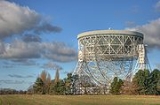
Jodrell Bank
Overview
The Jodrell Bank Observatory (originally the Jodrell Bank Experimental Station, then the Nuffield Radio Astronomy Laboratories from 1966 to 1999; ˈdʒɒdrəl) is a British observatory
that hosts a number of radio telescope
s, and is part of the Jodrell Bank Centre for Astrophysics
at the University of Manchester
. The observatory was established in 1945 by Sir Bernard Lovell
, who wanted to investigate cosmic ray
s after his work on radar
during the Second World War. It has since played an important role in the research of meteor
s, quasar
s, pulsar
s, masers
and gravitational lens
es, and was heavily involved with the tracking of space probe
s at the start of the Space Age
.
Observatory
An observatory is a location used for observing terrestrial or celestial events. Astronomy, climatology/meteorology, geology, oceanography and volcanology are examples of disciplines for which observatories have been constructed...
that hosts a number of radio telescope
Radio telescope
A radio telescope is a form of directional radio antenna used in radio astronomy. The same types of antennas are also used in tracking and collecting data from satellites and space probes...
s, and is part of the Jodrell Bank Centre for Astrophysics
Jodrell Bank Centre for Astrophysics
The Jodrell Bank Centre for Astrophysics at the University of Manchester, is among the largest astrophysics groups in the UK. It includes the world leading facilities of the Jodrell Bank Observatory, the MERLIN/VLBI National Facility, the Development Office of the Square Kilometre Array, and the...
at the University of Manchester
University of Manchester
The University of Manchester is a public research university located in Manchester, United Kingdom. It is a "red brick" university and a member of the Russell Group of research-intensive British universities and the N8 Group...
. The observatory was established in 1945 by Sir Bernard Lovell
Bernard Lovell
Sir Alfred Charles Bernard Lovell OBE, FRS is an English physicist and radio astronomer. He was the first Director of Jodrell Bank Observatory, from 1945 to 1980.-Early Life:...
, who wanted to investigate cosmic ray
Cosmic ray
Cosmic rays are energetic charged subatomic particles, originating from outer space. They may produce secondary particles that penetrate the Earth's atmosphere and surface. The term ray is historical as cosmic rays were thought to be electromagnetic radiation...
s after his work on radar
Radar
Radar is an object-detection system which uses radio waves to determine the range, altitude, direction, or speed of objects. It can be used to detect aircraft, ships, spacecraft, guided missiles, motor vehicles, weather formations, and terrain. The radar dish or antenna transmits pulses of radio...
during the Second World War. It has since played an important role in the research of meteor
METEOR
METEOR is a metric for the evaluation of machine translation output. The metric is based on the harmonic mean of unigram precision and recall, with recall weighted higher than precision...
s, quasar
Quasar
A quasi-stellar radio source is a very energetic and distant active galactic nucleus. Quasars are extremely luminous and were first identified as being high redshift sources of electromagnetic energy, including radio waves and visible light, that were point-like, similar to stars, rather than...
s, pulsar
Pulsar
A pulsar is a highly magnetized, rotating neutron star that emits a beam of electromagnetic radiation. The radiation can only be observed when the beam of emission is pointing towards the Earth. This is called the lighthouse effect and gives rise to the pulsed nature that gives pulsars their name...
s, masers
Astrophysical maser
An astrophysical maser is a naturally occurring source of stimulated spectral line emission, typically in the microwave portion of the electromagnetic spectrum...
and gravitational lens
Gravitational lens
A gravitational lens refers to a distribution of matter between a distant source and an observer, that is capable of bending the light from the source, as it travels towards the observer...
es, and was heavily involved with the tracking of space probe
Space probe
A robotic spacecraft is a spacecraft with no humans on board, that is usually under telerobotic control. A robotic spacecraft designed to make scientific research measurements is often called a space probe. Many space missions are more suited to telerobotic rather than crewed operation, due to...
s at the start of the Space Age
Space Age
The Space Age is a time period encompassing the activities related to the Space Race, space exploration, space technology, and the cultural developments influenced by these events. The Space Age is generally considered to have begun with Sputnik...
.
Unanswered Questions

